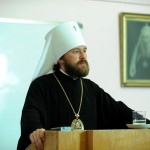by Metropolitan Hilarion Alfeyev
 Lecture delivered at the Kiev Theological Academy on September 20, 2002
Lecture delivered at the Kiev Theological Academy on September 20, 2002
“Canonical” and “uncanonical” services
All that has been said so far about the theological authority of liturgical texts relates to those found in the daily, weekly and annual cycle of services in the Service Book, the Book of Hours, the Octoechos, the Lenten Triodion, the Pentecostarion and the Menaia. Unfortunately, however, the contents of these books are not always accessible to the average Orthodox believer for several reasons.
First of all, the majority of these services are not celebrated in churches that do not have daily services, and even in those that do, they are abbreviated (the Synaxarion, for example, is left out almost everywhere). Secondly, liturgical texts are read and sung in Church Slavonic, which not everyone can understand. Thirdly, many hymns are sung in church only once or a few times during the year, and are difficult to understand when heard, even if one knows Church Slavonic. Fourthly, Orthodox liturgical texts are essentially works of Byzantine liturgical poetry translated into Slavonic many centuries ago, and are therefore quite difficult to understand without a knowledge of the original language or the rules of Byzantine poetics. Even if all liturgical texts were to be translated into Russian they would hardly become immediately understandable to everybody.
The only way to explore the riches of the Orthodox Church’s liturgical poetry is to study the texts systematically, just as one studies music, mathematics and other subjects. There are several ways to do this. One is to go to church every day and follow the service books as they are read and sung. Another is to read and sing in a choir. The third is to read liturgical books at home, and still another is to study Greek and Slavonic and compare the original text with the Slavonic translation.
But are such luxuries available to most Orthodox Christians? Of course, not. Typically, the majority are content with what they manage to understand during the services. Or, they try to make up for the lack of spiritual nourishment in church by resorting to various “uncanonical” services and prayers not contained in the Church’s prescribed liturgical books mentioned above. These other services and prayers include molebens and akathists that have entered our church practice over the past two or three centuries and are very popular among believers. Unlike the Byzantine hymns that are difficult to understand, these molebens and akathists do not demand a specialized intellectual effort or theological education for their understanding, since their content is quite simple. However, their theological value is incomparably lower than that of canonical liturgical texts since they contain, as do many Protestant and Catholic hymns, much “piety” but little theology.
What exactly is a moleben? The Orthodox Typicon knows of no such service. In essence, the moleben is the matins service abbreviated beyond recognition and almost totally devoid of theology. The theologically richest sections of matins are the stichera and canons which, as a rule, are totally discarded during the moleben except for refrains, such as
“Most Holy Mother of God, save us”,
“Our Holy Father Nicholas, pray to God for us”,
and the like. In my opinion, the nearly ubiquitous practice of serving molebens in Russia does not at all attest to the development of liturgical piety in the correct, “Orthodox” direction, but rather the opposite. We can say that processes are taking place in the Russian Church similar to those that occurred in Protestantism and Catholicism at various periods, during which ancient, theologically rich, liturgical texts were replaced by more easy-to-understand chorales, hymns and chants. The final stage of this process of liturgical impoverishment and simplification in the Catholic Church was marked by the reforms of Vatican II. In Protestantism, similar reforms were carried out at the very moment of its appearance in history.
In both cases, treasures of theological content were sacrificed for the sake of ease of comprehension. As a result, their services ceased to be a school of theology and meditation on God and remained at most a school of piety.
The widespread practice of serving akathists also does not argue for great optimism. The Orthodox Typicon knows of only one akathist – that served on Saturday of the fifth week of Great Lent. Other remarkable examples of this genre, such as those to the Most-Sweet Jesus and St Nicholas, were written in a similar manner. However, many akathists to saints written at a low theological and literary level appeared in the 18th and 19th centuries, in which theology was replaced by piety and meditation on God by “talking about God”. These are of questionable taste.
Currently many speak of the need to reform Orthodox services in order to make them more understandable and palatable. But if this is to be accomplished by the further removal of canonical liturgical texts and their replacement with works of popular art, I fear that such “reforms” will only bring forth bitter fruits.
I am deeply convinced that there is less a need to “revise” services as one to conform liturgical practice to the Typicon. In this way the faithful will have the possibility of rediscovering the treasures of Orthodox theology contained in canonical liturgical texts. In order to make them more understandable, Slavonic translations could be simplified. Of this much was spoken and written already in the 19th century. Several very difficult texts could be read or sung in Russian, although, in my opinion, a total russification of the services is inadmissible. In addition, one could print these liturgical texts in Slavonic with a parallel Russian translation and hand them out to the congregation before the beginning of services. Thus, not reforms of Orthodox services, but measures to help make their riches more accessible, are necessary.
